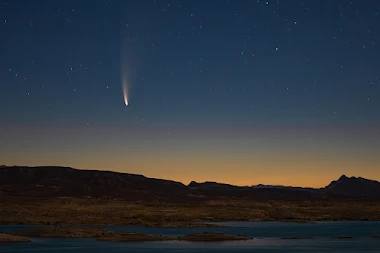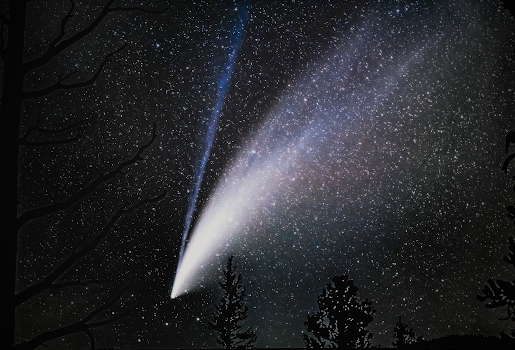A Peek into the Life and Death of a Comet
For the past few days, we've been keeping an eye on comet Neowise as it swings by the Sun. A sudden visitor, coming from the dark depths of the outer solar system, hailing from the early days of the solar system's formation, this chunk of rock contains clues to cosmic events while planet Earth was still accreting from the solar nebula. The best one since comet Hale-Bopp's arrival in 1997, Neowise, emerging from perihelion, shines lovely and bright. Comets, by their very nature, are transient visitors, like some of your itinerant uncles, stopping by once in forever. While my fingers race across the keyboard, typing out this article, C/2020 F3 Neowise passes by Jupiter, venturing out into the void of interstellar space from whence it came, not to return for the next 6,800 years or never at all.
But the good thing is there are plenty of comets, more than we can account for. The total number of cometary objects outnumber every living person on Earth by 1:125. That is to say, there are over a trillion comets and likely more. Insofar as less than only 4,000 of them are known. While some of them swing by every few decades or so, like the acclaimed Halleys comet, due to return sometime around 2061, others may happen to pass by only once, never to be found again, never to be seen again, and turned to interplanetary dust falling into an ill-fated hyperbolic orbit. Neowise is one of the latter kind. We may never see it again. Saying our goodbyes and wishing Neowise a safe journey ahead, let's take a quick peek into the life of a comet.
 |
| Comet Neowise photographed from Lake Mead National Recreation Area, Nevada, USA. Credits: James Marvin Phelps, Flickr Photos CC BY-NC 2.0 |
So What's A Comet?
A comet is a chunk of ice and rock that orbits the Sun as all planets do but in highly elongated and eccentric orbits. They are nothing but leftovers from the very early days of the solar system's formation. While more than 98% of the solar nebula contracted to what we see today as the Sun, the residual gas spun into a rapidly rotating disc surrounding the contracting proto-sun. Bit by bit, the accreting gas coalesced at first into nanoscopic particles of dirt, followed by microscopic aggregates. As time progressed, these minute debris, acted on by mutual gravity, combined into planetesimals. These planetesimals attracted more matter and grew large into planets. Some of them collided, broke apart, shattered to pieces, and reorganized themselves into the planets and their moons of now. Whatever planetesimals stayed untouched by the violent collisions that led to the current hierarchy of the solar system, they either turned up as asteroids, forming a torus between Mars and Jupiter, or settled as the so-called comets in a similar torus-shaped belt, the Kuiper Belt (named in honor of astronomer Gerard Kuiper) far beyond the orbit of Neptune.
Although comets share a kinship with asteroids, they are a distinct class of objects in their own right. For starters, comets are more ice than rock. They are nicknamed ''dirty snowballs'' or ''icy dirtballs'' after astronomer Fred Whipple's ''dirty snowball hypothesis'' wherein he emphasized that comets are a conglomerate of water ice, ammonia ice, and carbon dioxide ice mixed with rocks. Second, unlike asteroids, for most of the time, comets stay out in the extreme outskirts of the solar system. Lodged in eccentric orbits, as they near the Sun, solar radiation heats them, causing the ice to sublime, i.e., turn directly into gas. This outgassing gives them their glowing tails - dazzling bright against the dimly lit twilight sky. A widely recognized visage and unworldly beautiful, yet for thousands of years and even until not-so-recent times, they've always been the feared emissaries of impending doom.
Comets are of special interest to astronomers because they contain essential clues to the formation of the solar system, the planets, and the Sun. Tucked away far beyond the orbit of Neptune, 30 - 50 astronomical units (AU) where 1 AU equals the Earth-Sun distance of 150 million km, and even further into the Oort Cloud, some 2,000 - 200,000 AU from the Sun, these remnant bodies have remained virtually unchanged for the entire length of the solar system's age, i.e., for 4.5 billion years. Since comets contain high amounts of organic compounds, frozen hydrocarbon, and water ice mixed with rock, astronomers suppose they must've brought a significant amount of water to Earth. Other than that, what's more, they could be responsible for the very origin of life on Earth, supplying the barren terrestrial globe with the right chemistry.
Physical Characteristics of a Comet:
A comet has three parts, in principle.
- Nucleus - The core structure of a comet is always a misshapen dump of rocks, resembling anything from an overgrown tuber to an unlikely piece of Cheetos or a chicken wing. A comet's nucleus is a conglomerate of rock, dust, water ice, frozen carbon dioxide, carbon monoxide, methane, ammonia, and a host of organic hydrocarbons such as methanol, ethanol, ethane, hydrogen cyanide, formaldehyde, amino acids, viz., glycine, adenine, and guanine, the base molecules of DNA. Hence the name ''icy dirtballs'' - organic ice mixed with dirt, or ''dirty snowballs'' for those that are more ice than rock. Since their surfaces appear dusty or rocky, disfigured by cliffs and hills (for larger ones), astronomers can say for sure that comets conceal volumes of ice beneath the surface. One particular research done in 2014 suggests that the organic compounds rest on the surface like sprinkled icing sugar, while immediately below, the crust is of crystalline ice, and deeper still, the inner core turns out less dense and composed of older ice. Cometary nuclei have very low albedo. They're the least reflective of all objects in the solar system. Most comets are small, less than 10 km in diameter, although some can be as big as 30 - 60 km or bigger. Their smaller mass, however, explains their irregular appearance - they're not big enough for their gravity to pull them into spherical bodies like planets.
 |
| Comet 67P/Churyumov-Gerasimenko as imaged on March 15, 2017 by the Rosetta spacecraft. Built and launched by ESA, Rosetta was the first mission to orbit a comet, and land on it. Credits: Aster Cowart, Flickr Photos CC BY-NC 2.0 |
- Coma - Comets prefer to remain in the Kuiper Belt or the much farther Oort cloud, circling the Sun in their own torus. Due to the gravitational perturbations of Neptune (in the case of Kuiper Belt comets) and the occasional passage of some stars across the nearby interstellar space (for Oort cloud objects), they often fall into orbit around the Sun. But their highly eccentric orbits keep them far away from the Sun. As they close in on 3 - 4 AU from the Sun, the continuous solar radiation raises their surface temperatures to hundreds of degrees, which causes the ice to sublime. Through the cracks in the surface, the sublimated ice violently shoots outwards in high-pressure jets and geysers. These volatiles envelop the cometary nuclei with a tenuous atmosphere held in place by the comet's meager gravity. This interim atmosphere - coma - begins to glow because of photodissociation and photoionization - where a molecule splits respectively into its constituent atoms and ions when struck with solar radiation. As the comet passes through the inner solar system, the coma becomes increasingly luminous and visible to earthly observers. While the coma's dust reflects sunlight, the gaseous ions glow in specific colors - a characteristic signature of the organic material present in the comet. Most of the time, comae glow blue-green due to CN (cyanide) and C2 (dicarbon).
- Tail - As the comet enters the inner solar system, crossing the orbit of Mars, solar radiation pressure pushes the coma into a long tail. As a matter of fact, a comet has two tails - a dust tail and an ion tail. The ion tail, as the name implies, develops due to solar ultraviolet radiation splitting apart atoms into ions. The ion tail points directly away from the Sun as the solar wind carries the charged (ion) particles away from the comet. The dust tail, on the other hand, as its name implies, contains micro-particles of dust and dirt. Being unaffected by the charged solar wind, the dust tail trails off along the comet's orbital path. The ion tail typically glows blue - a sign of CO ions, while the dust tail reflects sunlight and shines off-white to a shade of yellow. Tails typically develop around the orbit of Mars as the comet continues falling into the inner solar system.
 |
| Even though a comet is usually small, just a few km in diameter, its tail may extend for hundreds of thousands, if not millions of km. Credits: NASA, via Public domain |
As already mentioned, in a way, comets are of two types: long-period comets and short-period comets. Short-period comets have orbital periods of less than 200 years. One popular candidate is Halley's Comet, which swings by every 75-76 years. Short-period comets are also referred to as periodic comets, for they return again and again. They don't have highly eccentric orbits, not extending beyond that of Jupiter, Neptune, or the Kuiper Belt. Unlike the periodic candidates, long-period comets have highly eccentric orbits. Having their origins in the Oort cloud, their orbital periods range from thousands to perhaps millions of years. One of the issues with long-period comets is that their highly eccentric orbit takes them too close to the Sun. Hence, most of them disintegrate as they reach perihelion. If not, then gravitational perturbations from Jupiter or any of the giant planets throw these comets into parabolic or hyperbolic trajectories. As such, they escape the solar system. Neowise is a typical example of a long-period comet.
A Comet's Fate
Comets have dark fates. A million-year orbital period doesn't guarantee its return after a million years. Gravitational perturbations, tiny effects adding up over the years, throw them into escape orbits or in a collision trajectory with some planet or perhaps one of its kind.
Comets have dark fates. A million-year orbital period doesn't guarantee its return after a million years. Gravitational perturbations, tiny effects adding up over the years, throw them into escape orbits or in a collision trajectory with some planet or perhaps one of its kind.
When they pass too close to the Sun, the latter's intense heat, ionizing radiation, and violent solar winds turn too much for these fragile relics. If it doesn't disintegrate from the brutalities of the Sun, every time a comet goes through perihelion, it loses a fraction of its aggregate mass. It gets smaller and smaller, weaker and weaker unless there's almost nothing left. Chipped away into a small rock, our once-a-comet settles down somewhere as a tiny dark asteroid - its every presence virtually wiped off from its keen earthly observers.
First Published: 15 August, 2020
Updated on: 03 September, 2023





Comments
Post a Comment